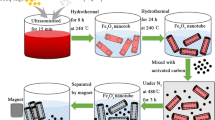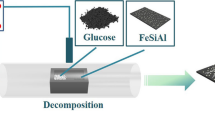Abstract
Although Fe3O4 particles have exhibited excellent microwave absorbing capacity and widely used in practical application due to the synergistic effect of magnetic loss and dielectric loss, their applications are still limited for the required high mass fraction in absorbers. To overcome this problem, the development of Fe3O4 materials with low dimensional structures is necessary. In this study, the shape anisotropic Fe3O4 nanotubes (NTs) with low mass ratios were applied to realize efficient microwave absorption. The NTs with different aspect ratios were prepared through facile electrospinning followed by two-step thermal treatments and mechanical shearing. The cross-linked nanotubular structure enabled the absorbers to have much higher electrical conductivity, multiple scattering, polarization relaxation and better anti-reflection surface, while the shape anisotropic NTs maintained significant multiple resonances with stronger coercivity. These all were beneficial to microwave absorption with enhanced dielectric loss, magnetic loss and sterling impedance matching. Results showed that the absorber with 33.3 wt.% of short Fe3O4 NTs had minimum reflection loss of -58.36 dB at 17.32 GHz with a thickness of 1.27 mm, and had the maximum effective absorbing bandwidth (EAB) of 5.27 GHz when the thickness was 1.53 mm. The absorber with 14.3 wt.% of long Fe3O4 NTs presented the widest EAB in certain radar band with attenuated 80.75% X band and 85% Ku band energy bellow -10 dB at the thickness of 2.65 and 1.53 mm, respectively. This study provided an approach for the development of shape anisotropic magnetic absorbing materials, and broadened their practical applications as magnetic absorbers.

Similar content being viewed by others
References
Ye, F.; Song, Q.; Zhang, Z. C.; Li, W.; Zhang, S. Y.; Yin, X. W.; Zhou, Y. Z.; Tao, H. W.; Liu, Y. S.; Cheng, L. F. et al. Direct growth of edge-rich graphene with tunable dielectric properties in porous Si3N4 ceramic for broadband high-performance microwave absorption. Adv. Funct. Mater.2018, 28, 1707205.
Li, X. L.; Yin, X. W.; Song, C. Q.; Han, M. K.; Xu, H. L.; Duan, W. Y.; Cheng, L. F.; Zhang, L. T. Self-assembly core-shell graphene-bridged hollow MXenes spheres 3D foam with ultrahigh specific EM absorption performance. Adv. Funct. Mater.2018, 28, 1803938.
Zhang, T.; Zhang, J.; Wen, G. W.; Zhong, B.; Xia, L.; Huang, X. X.; Zhao, H.; Wang, H. T.; Qin, L. C. Ultra-light h-BCN architectures derived from new organic monomers with tunable electromagnetic wave absorption. Carbon2018, 136, 345–358.
Song, W. L.; Guan, X. T.; Fan, L. Z.; Cao, W. Q.; Zhao, Q. L.; Wang, C. Y.; Cao, M. S. Tuning broadband microwave absorption via highly conductive Fe3O4/graphene heterostructural nanofillers. Mater. Res. Bull.2015, 72, 316–323.
Wang, Y. H.; Han, X. J.; Xu, P.; Liu, D. W.; Cui, L. R.; Zhao, H. H.; Du, Y. C. Synthesis of pomegranate-like Mo2C@C nanospheres for highly efficient microwave absorption. Chem. Eng. J.2019, 372, 312–320.
Zhou, Y. L.; Wang, N.; Muhammad, J.; Wang, D. X.; Duan, Y. P.; Zhang, X. F.; Dong, X. L.; Zhang, Z. D. Graphene nanoflakes with optimized nitrogen doping fabricated by are discharge as highly efficient absorbers toward microwave absorption. Carbon2019, 148, 204–213.
Guo, H.; Zhan, Y. Q.; Chen, Z. R.; Meng, F. B.; Wei, J. J.; Liu, X. B. Decoration of basalt fibers with hybrid Fe3O4 microspheres and their microwave absorption application in bisphthalonitrile composites. J. Mater. Chem. A2013, 1, 2286–2296.
Li, J. J.; Wu, Y. F.; Yang, M. L.; Yuan, Y.; Yin, W. L.; Peng, Q. Y.; Li, Y. B.; He, X. D. Electrospun Fe2O3 nanotubes and Fe3O4 nanofibers by citric acid sol-gel method. J. Am. Ceram. Soc.2017, 100, 5460–5470.
Yang, Z. H.; Li, M.; Zhang, Y.; Lyu, X. J.; Hu, D. H. Hierarchical formation mechanism of anisotropic magnetite microflakes and their superior microwave attenuation properties. J. Alloy. Compd.2019, 781, 321–329.
Zhu, T.; Chang, S. C.; Song, Y. F.; Lahoubi, M.; Wang, W. PVP-encapsulated CoFe2O4/rGO composites with controllable electromagnetic wave absorption performance. Chem. Eng. J.2019, 373, 755–766.
Liu, P. J.; Yao, Z. J.; Zhou, J. T.; Yang, Z. H.; Kong, L. B. Small magnetic Co-doped NiZn ferrite/graphene nanocomposites and their dual-region microwave absorption performance. J. Mater. Chem. C2016, 4, 9738–9749.
Hu, R. C.; Tan, G. G.; Gu, X. S.; Chen, S. W.; Wu, C. G.; Man, Q. K.; Chang, C. T.; Wang, X. M.; Li, R. W.; Che, S. L. et al. Electromagnetic and microwave-absorbing properties of Co-based amorphous wire and Ce2Fe17N3-δ composite. J. Alloy. Compd.2018, 730, 255–260.
Nam, Y. W.; Choi, J. H.; Lee, W. J.; Kim, C. G. Fabrication of a thin and lightweight microwave absorber containing Ni-coated glass fibers by electroless plating. Compos. Sci. Technol.2017, 145, 165–172.
Teber, A.; Unver, I.; Kavas, H.; Aktas, B.; Bansal, R. Knitted radar absorbing materials (RAM) based on nickel-cobalt magnetic materials. J. Magn. Magn. Mater.2016, 406, 228–232.
Peng, K. S.; Fang, G.; Guo, C.; Liu, C. Y.; Xu, G. Y.; Xiao, A. D.; Zhang, Y. T.; Zhang, Y. J. Microwave absorption enhancement of FeCoNi contributed by improved crystallinity and flake-like particles. J. Magn. Magn. Mater.2019, 490, 165488.
Zhang, X. K.; Xiang, J.; Wu, Z. P.; Gong, L.; Chen, X.; Guan, G. G.; Wang, Y.; Zhang, K. Y. Enhanced absorbing properties and structural design of microwave absorbers based on Ni0.8Co0.2Fe2O4 nanofibers and Ni-C hybrid nanofibers. J. Alloy. Compd.2018, 764, 691–700.
Gupta, K. K.; Abbas, S. M.; Abhyankar, A. C. Carbon black/polyurethane nanocomposite-coated fabric for microwave attenuation in X & Ku-band (8-18GHz) frequency range. J. Ind. Text.2016, 46, 510–529.
Wu, R. B.; Zhou, K.; Yang, Z. H.; Qian, X. K.; Wei, J.; Liu, L.; Huang, Y. Z.; Kong, L. B.; Wang, L. Y. Molten-salt-mediated synthesis of SiC nanowires for microwave absorption applications. CrystEngComm2013, 15, 570–576.
Wang, H. Y.; Zhu, D. M. Design of radar absorbing structure using SiCf/epoxy composites for X band frequency range. Ind. Eng. Chem. Res.2018, 57, 2139–2145.
da Silva, L. V.; Pezzin, S. H.; Rezende, M. C.; Amico, S. C. Glass fiber/carbon nanotubes/epoxy three-component composites as radar absorbing materials. Polym. Composite.2016, 37, 2277–2284.
Haji, A.; Rahbar, R. S.; Shoushtari, A. M. Improved microwave shielding behavior of carbon nanotube-coated PET fabric using plasma technology. Appl. Surf. Sci.2014, 311, 593–601.
Chen, H. H.; Huang, Z. Y.; Huang, Y.; Zhang, Y.; Ge, Z.; Qin, B.; Liu, Z. F.; Shi, Q.; Xiao, P. S.; Yang, Y. et al. Synergistically assembled MWCNT/graphene foam with highly efficient microwave absorption in both C and X bands. Carbon2017, 124, 506–514.
Zhang, Y.; Huang, Y.; Chen, H. H.; Huang, Z. Y.; Yang, Y.; Xiao, P. S.; Zhou, Y.; Chen, Y. S. Composition and structure control of ultralight graphene foam for high-performance microwave absorption. Carbon2016, 105, 438–447.
Zhang, Y.; Huang, Y.; Zhang, T. F.; Chang, H. C.; Xiao, P. S.; Chen, H. H.; Huang, Z. Y.; Chen, Y. S. Broadband and tunable high-performance microwave absorption of an ultralight and highly compressible graphene foam. Adv. Mater.2015, 27, 2049–2053.
Shahzad, F.; Alhabeb, M.; Hatter, C. B.; Anasori, B.; Hong, S. M.; Koo, C. M.; Gogotsi, Y. Electromagnetic interference shielding with 2D transition metal carbides (MXenes). Science2016, 353, 1137–1140.
Zhang, Q. C.; Du, Z. J.; Huang, X. Z.; Zhao, Z. X.; Guo, T.; Zeng, G. J.; Yu, Y. T. Tunable microwave absorptivity in reduced graphene oxide functionalized with Fe3O4 nanorods. Appl. Surf. Sci.2019, 473, 706–714.
Qiao, M. T.; Lei, X. F.; Ma, Y.; Tian, L. D.; He, X. W.; Su, K. H.; Zhang, Q. Y. Application of yolk-shell Fe3O4@N-doped carbon nanochains as highly effective microwave-absorption material. Nano Res.2018, 11, 1500–1519.
Han, R.; Li, W.; Pan, W. W.; Zhu, M. G.; Zhou, D.; Li, F. S. 1D magnetic materials of Fe3O4 and Fe with high performance of microwave absorption fabricated by electrospinning method. Sci. Rep.2014, 4, 7493.
Sui, M. X.; Sun, X. D.; Lou, H. F.; Li, X. P.; Lv, X. L.; Li, L.; Gu, G. X. Synthesis of hollow Fe3O4 particles via one-step solvothermal approach for microwave absorption materials: Effect of reactant concentration, reaction temperature and reaction time. J. Mater. Sci.: Mater. Electron.2018, 29, 7539–7550.
Han, M. G.; Deng, L. J. Doping effect of multiwall carbon nanotubes on the microwave electromagnetic properties of NiCoZn spinel ferrites. Appl. Phys. Lett.2007, 90, 011108.
Wang, Y.; Li, D.; Ma, Q. L.; Tian, J.; Song, Y.; Xi, X.; Dong, X. T.; Yu, W. S.; Wang, J. X.; Liu, G. X. A novel and facile approach to obtain NiO nanowire-in-nanotube structured nanofibers with enhanced photocatalysis. RSC Adv.2018, 8, 11051–11060.
Zhao, L. J.; Yang, H.; Zhao, X. P.; Yu, L. X.; Cui, Y. M.; Feng, S. H. Magnetic properties of CoFe2O4 ferrite doped with rare earth ion. Mater. Lett.2006, 60, 1–6.
Deng, L. J.; Zhou, P. H.; Xie, J. L.; Zhang, L. Characterization and microwave resonance in nanocrystalline FeCoNi flake composite. J. Appl. Phys.2007, 101, 103916.
Lv, H. L.; Liang, X. H.; Ji, G. B.; Zhang, H. Q.; Du, Y. W. Porous three-dimensional flower-like Co/CoO and its excellent electromagnetic absorption properties. ACS Appl. Mater. Interfaces2015, 7, 9776–9783.
Yan, J.; Huang, Y.; Chen, C.; Liu, X. D.; Liu, H. The 3D CoNi alloy particles embedded in N-doped porous carbon foams for high-performance microwave absorbers. Carbon2019, 152, 545–555.
Song, Z. M.; Liu, X. F.; Sun, X.; Li, Y.; Nie, X. Y.; Tang, W. K.; Yu, R. H.; Shui, J. L. Alginate-templated synthesis of CoFe/carbon fiber composite and the effect of hierarchically porous structure on electromagnetic wave absorption performance. Carbon2019, 151, 36–45.
Yan, F.; Kang, J. Y.; Zhang, S.; Li, C. Y.; Zhu, C. L.; Zhang, X. T.; Chen, Y. J. Enhanced electromagnetic wave absorption induced by void spaces in hollow nanoparticles. Nanoscale2018, 10, 18742–18748.
Shukla, V. Review of electromagnetic interference shielding materials fabricated by iron ingredients. Nanoscale Adv.2019, 1, 1640–1671.
Wen, F. S.; Yi, H. B.; Qiao, L.; Zheng, H.; Zhou, D.; Li, F. S. Analyses on double resonance behavior in microwave magnetic permeability of multiwalled carbon nanotube composites containing Ni catalyst. Appl. Phys. Lett.2008, 92, 042507.
Xu, D. W.; Yang, S.; Chen, P.; Yu, Q.; Xiong, X. H.; Wang, J. Synthesis of magnetic graphene aerogels for microwave absorption by in-situ pyrolysis. Carbon2019, 146, 301–312.
Li, J. J.; Feng, Y. Z.; Wu, Y. F.; Yuan, Y. Fiber-guided and particle-localized microwave absorption of nanoscale CoFe2O4 derived from citric acid-based precursor. Phys. B2019, 561, 16–22.
Acknowledgements
This work was supported by the National Key Research and Development Program of China (No. 2017YFB1104300), National Natural Science Foundation of China (No. 51672150), and Tsinghua University Initiative Scientific Research Program.
Author information
Authors and Affiliations
Corresponding author
Electronic Supplementary Material
Rights and permissions
About this article
Cite this article
Pan, J., Guo, H., Wang, M. et al. Shape anisotropic Fe3O4 nanotubes for efficient microwave absorption. Nano Res. 13, 621–629 (2020). https://doi.org/10.1007/s12274-020-2656-5
Received:
Revised:
Accepted:
Published:
Issue Date:
DOI: https://doi.org/10.1007/s12274-020-2656-5




